

Monitorin GMO lista zadań.xlsx - Arkusze Google. Diacetyl control during brewery fermentation via adaptive laboratory engineering of the lager yeast Saccharomyces pastorianus. Skip to Main Content Advertisement Search Close Advanced Search Search Menu.

Selection of Saccharomyces pastorianus variants with improved fermentation performance under very high gravity wort conditions. Blieck L, Toye G, Dumortier F, Vertrepen KJ, Delvaux FD, Thevelein JM, Vandijck P (2007) Isolation and characterization of brewer’s yeast variants with improved fermentation performance under high-gravity conditions.
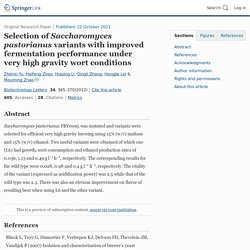
Appl Environ Microbiol 73:815–824PubMed Article CAS Google Scholar Cooper DJ, Stewart GG, Bryce JH (1998) Some reasons why high gravity brewing has a negative effect on head retention. J Inst Brew 104:83–87CAS Google Scholar de Smidt O, du Preez JC, Albertyn J (2008) The alcohol dehydrogenases of Saccharomyces cerevisiae: a comprehensive review. FEMS Yeast Res 8:967–978PubMed Article Google Scholar Gabriel P, Dienstbier M, Matoulková D, Kosař K, Sigler K (2008) Optimised acidification power test of yeast vitality and its use in brewing practice. J Inst Brew 114:270–276 Google Scholar Gibson B, Lawrence SJ, Leclaire JPR, Powell CD, Smart KA (2007) Yeast responses to stresses associated with industrial brewery handling.
Selection of Saccharomyces pastorianus variants with improved fermentation performance under very high gravity wort conditions. Lager-brewing yeasts in the era of modern genetics. We use cookies to enhance your experience on our website.
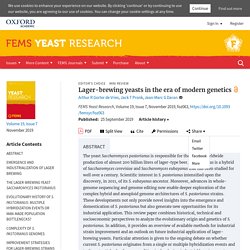
By clicking 'continue' or by continuing to use our website, you are agreeing to our use of cookies. You can change your cookie settings at any time. Applied and Environmental Microbiology 2008 González 2314. Metal uptake capacity of modified Saccharomyces pastorianus biomass from different types of solution. Aksu Z, Donmez G (2006) Binary biosorption of cadmium(II) and nickel(II) onto dried Chlorella vulgaris: co-ion effect on mono-component isotherm parameters.

Process Biochem 41:860–868CAS Article Google Scholar Avery SV, Tobin JM (1992) Mechanisms of strontium uptake by laboratory and brewing strains of Saccharomyces cerevisiae. Appl Environ Microbiol 58:3883–3889CAS Google Scholar Brady D, Stoll A, Duncan JR (1994) Biosorption of heavy metal cations by non-viable yeast biomass. Environ Technol 15:429–438CAS Article Google Scholar Chojnacka K (2010) Biosorption and bioaccumulation—the prospects for practical applications. Environ Int 36:299–307CAS Article Google Scholar Ferraz AI, Teixeira JA (1999) The use of flocculating brewer’s yeast for Cr(III) and Pb(II) removal from residual wastewaters.
Metal uptake capacity of modified Saccharomyces pastorianus biomass from different types of solution. The use of genetically modified Saccharomyces cerevisiae strains in the wine industry. Ahmed FE (2002) Detection of genetically modified organisms in foods.
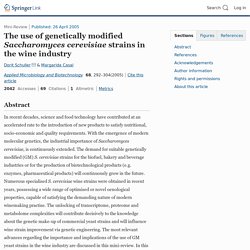
Trends Biotechnol 20:215–223 Google Scholar Akada R (2002) Genetically modified industrial yeast ready for application. J Biosci Bioeng 94:536–544 Google Scholar Akada R, Matsuo K, Aritomi K, Nishizawa Y (1999) Construction of recombinant sake yeast containing a dominant FAS2 mutation without extraneous sequences by a two-step gene replacement protocol. J Biosci Bioeng 87:43–48 Google Scholar Anonymous (2001) Europeans, Science and Technology (Eurobarometer 55.2), Brussels, European Opinion Research Group, available (April 2005) at K, Hirosawa I, Hoshida H, Shiigi M, Nishizawa Y, Kashiwagi S, Akada R (2004) Self-cloning yeast strains containing novel FAS2 mutations produce a higher amount of ethyl caproate in Japanese sake.
Biosci Biotechnol Biochem 68:206–214 Google Scholar Auer CA (2003) Tracking genes from seed to supermarket: techniques and trends. Applied and Environmental Microbiology 1992 Avery 3883. Genetic engineering of brewing yeast to reduce the content of ethanol in beer. Skip to Main Content Advertisement Search Close.

Inheritance of brewing-relevant phenotypes in constructed Saccharomyces cerevisiae × Saccharomyces eubayanus hybrids. Yeast strains and hybrid generation The yeast strains used in the study are listed in Table 1.
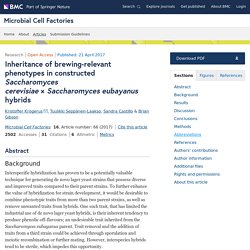
The interspecific yeast hybrids H1 (P1 × P2) and H2 (P2 × P3) and intraspecific yeast hybrid H3 (P1 × P2) were generated using rare mating according to the method described in Krogerus et al. [3]. Prior to mating, a uracil auxotroph (ura-) of P1 was selected on 5-fluoroorotic acid (5-FOA) agar [43], a respiratory-deficient mutant (rho-) of P2 was selected on YPDG agar containing 3% glycerol and 0.1% glucose, and a lysine auxotroph (lys-) of P3 was selected on α-aminoadipic (α-AA) agar [44] to allow for the selection of hybrids on minimal selection agar medium (0.67% Yeast Nitrogen Base without amino acids, 3% glycerol, 3% ethanol and 2% agar).
The interspecific hybrid H1 was further mated with P2 (rho-) to form the interspecific triple hybrid T1 [(P1 × P3) × P2]. A re-evaluation of diastatic Saccharomyces cerevisiae strains and their role in brewing. After the gene responsible for the diastatic phenotype was discovered, it was revealed that STA1 appeared to be chimeric (Fig. 1a), resulting from the fusion of FLO11 and SGA1 (Yamashita et al. 1987; Lo and Dranginis 1996).
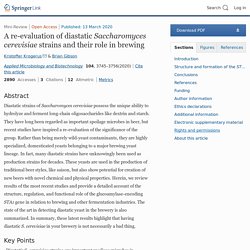
These genes are located on opposite ends of chromosome IX in S. cerevisiae. The 3′ end of STA1 is homologous to SGA1, a gene encoding an intracellular glucoamylase that is used during sporulation. The catalytic domain of STA1 is located in this SGA1-derived peptide (Adam et al. 2004). Construction of killer industrial yeast Saccharomyces cerevisiae HAU-1 and its fermentation performance. Construction of killer industrial yeast Saccharomyces cerevisiae HAU-1 and its fermentation performance Bijender K.

BajajI,*; S.